24 Hours Hotline: +8613735411378
Email:chengdu@tripstoshanghai.com
24 Hours Hotline: +8613735411378
Email:chengdu@tripstoshanghai.com
Steaming hotpot, floating skyscrapers, neon-lit riverbanks, and the wildest metro ride you’ve ever seen — welcome to Chongqing, China’s mountain metropolis and one of the country’s most underrated travel gems.
Often called “China’s City of Fog” or the “8D City” for its surreal vertical geography, Chongqing blends urban adrenaline with ancient culture, spicy cuisine, and jaw-dropping natural scenery. Whether you're a foodie, explorer, photographer, or cultural traveler, Chongqing has something waiting for you.
Here’s everything you need to know before you go — and why this city should be at the top of your China bucket list.
Why Visit Chongqing?
A City of Contrasts – Where ancient meets cyberpunk (think: thousand-year-old temples next to glowing high-rises).
Food Heaven – The spiciest hotpot on Earth and mouth-numbing Sichuan flavors await.
Unreal Landscapes – Built on mountains and rivers, it’s China’s most 3D city (stairs, elevators, and cable cars replace flat roads).
Gateway to the Yangtze – Jump on a cruise to the Three Gorges or explore nearby Wulong Karst Park (a Avatar-like wonder).
Where Is Chongqing?
Chongqing is a sprawling mega-city in southwestern China, surrounded by mountains and rivers, sitting at the confluence of the Yangtze and Jialing Rivers. It’s a municipality in its own right — the largest of its kind in China — with a population of over 30 million people. Unlike other major Chinese cities, Chongqing isn’t flat — it climbs, dips, and twists along cliffs and hillsides, giving it a dynamic topography that feels like something from a science-fiction novel.
What to See (Must-Visit Attractions)
1. Urban Landmarks & Architectural Wonders
Hongya Cave (Day vs. Night)
By day, this 11-story stilted marvel showcases traditional Bayu-style diaojiaolou – wooden houses built on cliffs. By night, it transforms into a neon-drenched cyberpunk dream, with golden lights cascading down the terraces like a waterfall.
Pro Tip: The best view is from Qiansimen Bridge at dusk.
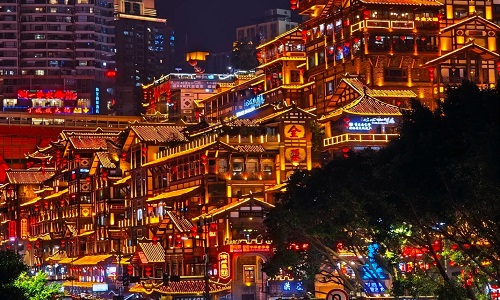
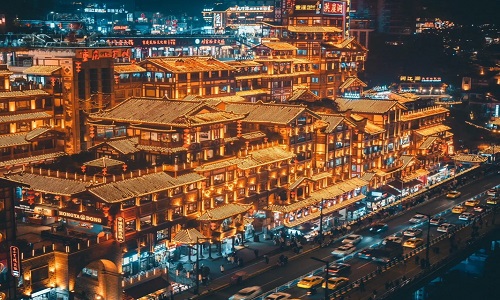
Liziba Light Rail Transit (Train Through a Building)
The world’s only metro train that pierces through a residential complex (6th-8th floors!). Watch from the viewing platform below or ride Line 2 for a surreal "Inception" moment.
Fun Fact: Residents barely notice the vibrations—it’s that smoothly engineered!
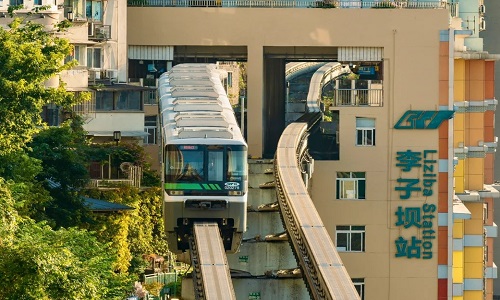
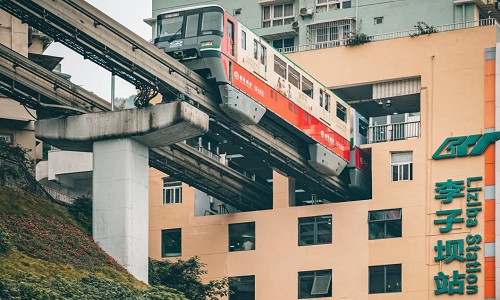
Raffles City Chongqing (The "Sail" by the River)
This $3.8 billion futuristic complex resembles a spaceship docking at Chaotianmen, where the Yangtze and Jialing Rivers collide. Visit the 250m-high Sky Walk for dizzying city-and-river panoramas.
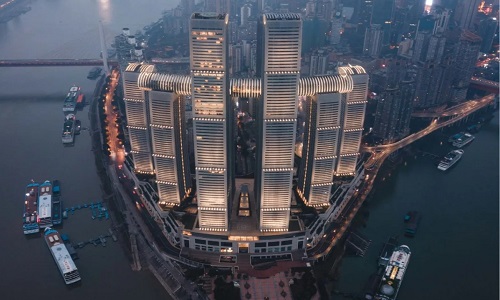
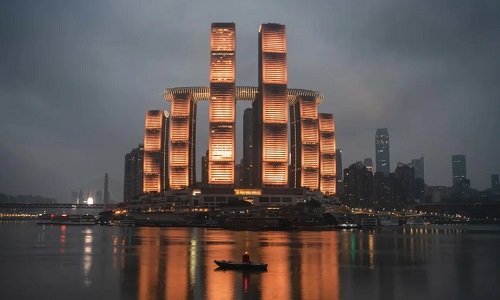
2. Natural Wonders
Wulong Karst (UNESCO World Heritage)
Three Natural Bridges – Walk beneath the 100m-tall limestone arches (filmed in Transformers 4).
Furong Cave – A 5km-long underground kingdom with glowing stalactites.
Longshuixia Fissure – Descend into a jungle-covered canyon.
How to Get There: 2.5-hour scenic drive (or join a guided tour).
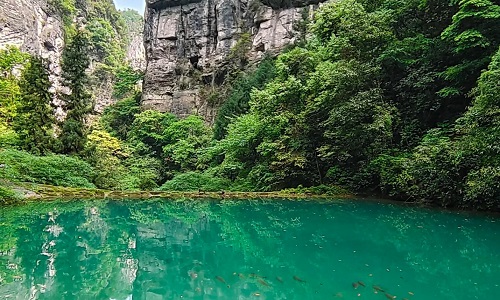
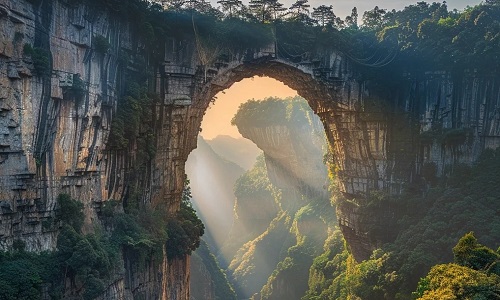
Yangtze River Three Gorges Cruise
Qutang Gorge – Narrowest and most dramatic cliffs.
Wu Gorge – Misty peaks immortalized in Chinese paintings.
Xiling Gorge – White-water rapids (opt for a speedboat thrill ride).
Best Cruise: 4D3N luxury ships with balcony cabins (Victoria Cruises recommended).
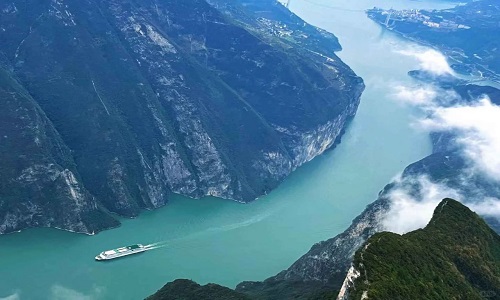
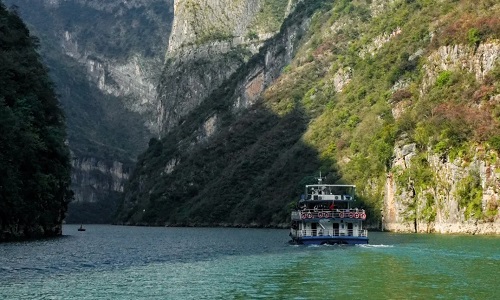
Nanshan "One Tree" Observatory
The highest vantage point over Chongqing’s skyline. Arrive before sunset to see the city transition from daylight to neon galaxy.
3. History & Culture
Ci Qi Kou (Porcelain Village)
A Ming Dynasty trading port now packed with:
Tea houses serving iron-kettle-brewed chrysanthemum tea.
Hand-pulled noodle demos in cobbled alleys.
Hidden courtyards where artisans make Shu embroidery.
Huguang Guild Hall
A 300-year-old complex built by Hubei immigrants, featuring:
Intricate wood carvings of dragons and phoenixes.
Opera stages where Sichuan face-changing shows still occur.
Three Gorges Museum
Don’t Miss:
The 360° Three Gorges diorama.
WWII relics from Chongqing’s time as China’s wartime capital.
What to Do (Must-Experience Activities)
1. Food Adventures
Chongqing Hotpot 101
Order Like a Local: "Niú du" (beef tripe), "huáng hóu" (pig throat cartilage), "ya cháng" (duck intestine).
DIY Oil Dip: Sesame oil + garlic + cilantro + a dash of MSG (trust us).
Spice Levels: "Wei là" (mild) "Biàn tài là" ("psycho spicy").
Street Food Crawl
Xiao Mian: Chewy noodles in peanut-chili sauce (try Banana Fish Noodles).
Suan La Fen: Clear sweet-potato noodles in vinegar-chili broth.
Grilled Skewers: "Nao hua" (pig brain) and "zhu bí lián" (pig nostrils—yes, really).
Hidden Gems
Residential Block Eateries: Follow the chili fumes in old apartment buildings.
Midnight Noodle Carts: Hunt for 3am dan dan mian near Jiefangbei.
2. Unique Transportation Experiences
Yangtze River Cable Car
Best Time: Sunset (golden hour over the river).
Photo Hack: Press against windows for reflective cityscape shots.
Hongtudi Escalator (Asia’s Longest Inclined Elevator)
A 112m-long ride at a 30° angle—locals use it as a commuting shortcut.
Shancheng Trail Hike
A staircase-heavy walk past:
1940s brick houses clinging to cliffs.
Secret art installations in alleyway nooks.
3. Nightlife Guide
Nanbin Road Light Show
Laser projections dance across skyscrapers and bridges nightly at 8pm.
Beicang Art District
Hidden Bars: Speak-easy cocktails in converted warehouses.
Live Music: Indie bands at Nuts Club.
Jiaochangkou Night Market
Post-Midnight Bites: Spicy crayfish, grilled squid with cumin.
Street Performers: Mahjong-playing grandpas vs. TikTok dancers.
Nature & Day Trips: Get Out and Explore
1. Wulong Karst National Geology Park
A UNESCO World Heritage site about 3 hours from the city. Featuring jaw-dropping limestone formations, sinkholes, caves, and natural bridges — including filming locations from Transformers 4.
2. Dazu Rock Carvings
These incredible Buddhist carvings date back to the 7th century and are among China’s most important cultural relics. A perfect spiritual and artistic escape.
3. Fairy Mountain
Chongqing’s answer to a mountain resort — cool in summer, snowy in winter. Great for hiking, horseback riding, or simply escaping the city fog.
Suggested Itineraries: See More in Less Time
3-Day Classic City Tour
Day 1: Arrival, Hongya Cave exploration, Jiefangbei CBD walk, Yangtze Cable Car ride at sunset
Day 2: Liziba Monorail, Three Gorges Museum, Ciqikou Ancient Town, hotpot dinner experience
Day 3: Eling Park morning hike, local market shopping, optional foot massage or cruise
5-Day Explorer’s Adventure
Day 1: Jiefangbei arrival, city walk, and local dinner
Day 2: Wulong Karst National Park full-day trip — explore caves and natural bridges
Day 3: Return, relax in a hot spring (Ronghui or South Hot Spring), visit Eling Park
Day 4: Dazu Rock Carvings tour, Ciqikou shopping, evening hotpot feast
Day 5: River cruise, modern bookstore visit (Zhongshuge), final shopping and departure
Day Trips & Nearby Excursions
Wulong Karst National Park: A full day of stone bridges, sinkholes, and scenic hikes. The site of the Transformers 4 movie, this is geological drama at its best.
Dazu Rock Carvings: These 9th–13th century Buddhist masterpieces combine artistic expression with religious devotion.
Fairy Mountain: Nicknamed the “Little Switzerland” of China, it offers grassland hikes in summer and snow fun in winter.
Black Mountain Valley: Lush gorges, waterfalls, and ziplines — an adrenaline-packed option just outside the city.
Chengdu Excursion: Ride the bullet train to Chengdu (2 hours) for pandas, spicy street snacks, and Sichuan opera — a natural extension to your Chongqing trip.
What to Eat in Chongqing
Chongqing is China’s spicy food capital, and no trip is complete without sampling these local favorites:
Chongqing Hotpot: Known for its numbing spiciness and bubbling red broth, this is the city’s culinary pride.
Xiaomian: Spicy, addictive, and found on almost every corner, this humble noodle dish is beloved by locals.
Grilled skewers and street snacks: Try grilled tofu, rabbit heads (if you’re adventurous), and fried sticky rice cakes.
Tip: Order “shao la” (less spicy) if you’re not used to very spicy food!
Where to Stay in Chongqing
Best Areas:
Jiefangbei CBD: Central and walkable, close to major attractions and shopping.
Shapingba: More local, near universities and cultural sites.
Nan’an District: Offers great river views and quick access to the Yangtze Cableway.
Chongqing has a wide range of accommodations — from budget hostels to luxury hotels like the JW Marriott or Niccolo Chongqing.
Getting Around Chongqing
Metro: Fast and affordable. Chongqing’s metro system is extensive, clean, and scenic — especially Line 2, which runs through buildings!
Taxi or Didi (Chinese Uber): Useful for areas not well connected by subway. Be prepared for the city's steep roads and traffic.
Escalators and elevators: Due to the hilly landscape, the city is full of public escalators — the Liziba Escalator is the longest in Asia!
Local Tips and Cultural Insights
Language: Most locals speak Mandarin with a distinct Chongqing accent. Few speak English, so translation apps are helpful.
Weather: Summers are hot and humid (often over 35°C), while winters are damp and foggy. Spring and autumn are the most comfortable times to visit.
Cashless payments: Alipay and WeChat Pay are widely used, but international cards may not be accepted in small shops — carry some cash.
Bonus: Yangtze River Cruise
Chongqing is the main departure point for Yangtze River cruises through the Three Gorges — a fantastic way to see China’s longest river and stunning cliff landscapes. Cruises typically range from 3–5 days.
How to Get There
By Air: Chongqing Jiangbei International Airport (CKG) connects to major cities in China and Asia.
By High-Speed Rail: From Chengdu (2 hrs), Xi’an (5 hrs), or even Shanghai (11 hrs).
Final Thoughts
Chongqing is a city that surprises you — built on cliffs and hills, full of steamy streets and red chili aromas, ancient culture and futuristic skylines. It's unlike any other place in China.
Chongqing Shopping & Souvenirs
Hotpot Kits: Get sealed packets of spicy base with oil, peppercorn, and spices from brands like Dezhuang or Qiqi. Great gifts for friends.
Laziji Snacks: Fried chicken bits with dried chili — crispy, spicy, and addictive.
Tujia Folk Art: Wooden masks, silver jewelry, and traditional embroidery reflect the culture of Chongqing’s ethnic groups.
Cultural Bookstores: Zhongshuge isn’t just a bookstore — it’s an architectural wonder with spirals, arches, and illusions.
Retro Markets: Visit Erling or E’ling Test Street for vintage film cameras, Mao-era posters, enamel mugs, and nostalgic finds.
Know Before You Go: Essential Chongqing Travel Tips
Best Time to Visit
Ideal Seasons:
Spring (March-May) – Mild temperatures (15-25°C), blooming flowers, and fewer crowds. Perfect for hiking and outdoor exploration.
Autumn (September-November) – Crisp air (18-28°C), golden foliage, and clear skies. Best for photography and river cruises.
Avoid July-August:
Chongqing is one of China’s "Three Furnaces," with temperatures soaring above 40°C (104°F) and 90% humidity. Even locals escape to cooler areas!
Transportation Warnings
Taxi Tips:
Learn key phrases like:
"Qing kào jiebian tíng" – "Please pull over here."
"Zài nàge hóngludeng guai" – "Turn at that traffic light."
Hailing Tricks: Avoid rush hours (7-9am, 5-7pm). Use DiDi (China’s Uber) for English-friendly rides.
Metro Survival Guide:
Line 2 and 3 offer the most scenic routes (crisscrossing rivers and mountains).
Download "MetroMan" app for real-time updates.
Walking Reality Check:
Google Maps fails in Chongqing’s 3D maze. Ask locals: "Zhè tiáo lù zenme zou?" – "How do I walk there?"
Comfortable shoes are a must—expect stairs, slopes, and footbridges.
Cultural Tips
Personality Traits:
Direct & Fiery – Don’t mistake bluntness for rudeness. Locals call it "gàncuì" (straightforward).
Humor-Loving – Jokes fly fast in teahouses. If someone teases you, tease back!
Night Owls – Streets buzz past midnight. Join a 2am hotpot session to bond with locals.
Emergency Kit:
Milk/Yogurt – Best for neutralizing capsaicin.
"Làozihào" Pharmacies – Ask for "xiaoyán piàn" (anti-inflammatory pills) if your stomach rebels.
Secret Menu Hack: Say "Wo yào wei là" for "mild spicy," or "Bù yào là" for no spice.
Tourist Trap Alerts:
Hongya Cave at Night – Stunning but overcrowded. Go weekday mornings instead.
"Free" Tea Ceremonies – Some scam tourists into buying overpriced tea leaves. Politely decline.
Deep-Dive Experiences
Day Trips Beyond the City
Dazu Rock Carvings (2h away):
UNESCO-listed 9th-century Buddhist sculptures. Don’t miss the "Circle of Life" relief.
Gongtan Ancient Town (4h away):
A Wulong Karst-adjacent gem with untouched Ming-era wooden houses.
Photographer’s Cheat Sheet
Iconic Shots:
Liziba Light Rail Station – Capture trains piercing apartments (use 70mm+ lens).
Yangtze River Cable Car at Sunset – Ride at 6-7pm for golden-hour cityscapes.
White Elephant Residence – Vintage staircases framing modern skyscrapers.
Unusual Local Experiences
Face-Changing Opera (Bian Lian):
At CiQiKou Tea House, actors magically swap masks in seconds. Tip: Front-row seats cost ~¥50.
Ear Cleaning (Cai Er):
Try it in Hongyadong’s back alleys. The tingling tools feel oddly satisfying!
Foot Massage with a View:
"Yun Ding" chain stores offer reflexology while you gaze at Jiangbei’s skyline.
Pro Tip Mix & Match
For Foodies: Pair málà hotpot with local craft beer
For Thrill-Seekers: Ride a motorcycle taxi through Nan’an District’s hairpin turns (hold tight!).
For Culture Nerds: Visit Luohan Temple at dawn to hear monks chant amid skyscrapers.
Chongqing rewards the prepared traveler. Master these tips, and you’ll navigate the city like a laochóngqìng (old-school local)!
City Comparison Guide
Chongqing vs. Chengdu: The Ultimate Rivalry
Though often lumped together as Sichuan neighbors, these two megacities couldn’t be more different.
Vibe & Atmosphere
Chongqing: Cyberpunk-meets-mountain village, with neon-lit cliffs, roaring rivers, and a gritty, industrial edge.
Chengdu: Flatter, greener, and more leisurely—think teahouse culture, wide boulevards, and panda-paced living.
Food Face-Off
Chongqing Hotpot: Thick, fiery red broth with Sichuan peppercorns that numb your lips. No dipping sauces—just pure, unapologetic spice.
Chengdu Hotpot: Milder (relatively!), with complex herbal broths and endless condiment stations.
Getting Around
Chongqing: A 3D maze where taxis climb 45-degree slopes, and Google Maps gives up.
Chengdu: Bike-friendly grids where even the subway feels orderly.
Day Trips
From Chongqing: Dramatic karst landscapes (Wulong) or the Yangtze’s Three Gorges.
From Chengdu: Leshan’s Giant Buddha or Qingcheng Mountain’s Taoist temples.
Verdict: Love adrenaline, spice, and jaw-dropping vistas? Chongqing. Prefer chill vibes and cultural polish? Chengdu.
Old vs. New Chongqing: The City’s Dueling Identities
Chongqing’s skyline rockets into the future—but its soul lingers in alleyways.
Shibati (18 Steps) – Then & Now
Old: Crumbling staircases where laundry fluttered between wooden homes, and "bangbang" porters shouldered goods up the slopes.
New: A gentrified "old town" with Instagrammable murals, craft beer pubs, and souvenir shops—still atmospheric, but sanitized.
The Yangtze’s Changing Face
Old: Fishing junks and cargo docks where workers smoked on bales of goods.
New: Luxury cruise terminals and the Raffles City complex, a spaceship-like megamall.
Pro Tip: For untouched old Chongqing, head to Ci Qi Kou’s back alleys or Nanshan’s hidden villages.
Traveler-Specific Guides
For Families with Kids
Chongqing Zoo: Meet "the spicy pandas"—locals joke they’re tougher than Chengdu’s.
Happy Valley: Roller coasters with skyline views (try the Flying Over Mountain ride).
Indoor Escapes: Chongqing Science Museum or Haichang Ocean Park on scorching days.
For Accessibility Challenges
Chongqing’s stairs, hills, and lack of ramps make it Asia’s ultimate mobility test. Still, it’s possible:
Flat Zones: Jiefangbei CBD (elevated walkways) or Hongya Cave’s elevators.
Taxis: Cheap and essential—ask for "píng lù" (flat routes).
Cruises: The Yangtze boats are wheelchair-friendly.
Honest Note: Many "old town" areas are impossible with wheelchairs. Prioritize riverfront paths and metro Line 3 (has elevators).
Final Tip: Whether you’re comparing cities or eras, Chongqing rewards flexibility—and strong calf muscles. Pack gel insoles and an open mind!
Hidden Gems & Offbeat Adventures
1. Urban Exploration: Forgotten Ruins & Industrial Relics
Chongqing Iron & Steel Factory Ruins
Step into a post-apocalyptic playground where rusted machinery and abandoned factories create a surreal, Blade Runner-esque landscape. Once the heart of Chongqing's industrial might, this sprawling complex now offers:
Photographer's paradise: Capture striking contrasts of decaying steel structures against the Yangtze River backdrop.
Golden Hour magic: Best light at dusk when orange beams filter through broken windows.
Local lore: Workers' graffiti and preserved 1950s Soviet-style architecture whisper tales of China's industrial revolution.
Baishatuo Ancient Street
Time-capsule alert! This unspoiled Qing Dynasty riverside village (1.5h from downtown) feels like walking onto a period film set:
Authentic wooden stilt houses tilting precariously over stone steps.
Last-standing tea houses where elderly locals play mahjong on century-old tables.
Pro tip: Visit weekdays—weekends see rare but growing tourist trickle.
2. Underground & Cave Adventures
Beibei Zhangfei Ancient Trail Wild Hot Springs
Combine hiking and hydrotherapy along this jungle-shrouded riverside path:
3km trail leads to natural sulfur springs (45°C) bubbling from cliffside cracks.
Local ritual: Soak feet while drinking wild chrysanthemum tea sold by mountain grannies.
Caution: Rocky path—wear grippy shoes!
Banan Longquan Cave Underground River
Paddle through China's answer to the River Styx in this 2km-long karst cave system:
Rowboat rentals (¥50) navigate bioluminescent pools lit by headlamps.
Spooky spectacle: Bats flutter past 15m-high stalactite "chandeliers"
Dry option: Walk the illuminated boardwalk if spelunking isn't your style.
3. Bizarre Urban Phenomena
Baixiangju Residential Complex
A vertical labyrinth where daily life defies physics:
24 floors with zero elevators—watch residents carry fridges up staircases like ant colonies.
"1st floor" exits to street, 15th floor opens to another road—thanks to mountain terrain.
Film buff alert: Key location in Chongqing Hot Pot movie—find the cliff side mahjong room.
Chaotianmen Wholesale Market at 4 AM
Where Chongqing's nocturnal economy thrives:
Miles of neon-lit stalls selling everything from live eels to LED Buddha statues.
"Bamboo pole army" porters haul goods with 200kg loads on shoulder poles.
Must-try: 5am breakfast of spicy wontons from decades-old pushcarts.
Caijiaba Railway Station
A dieselpunk dreamscape frozen in the 1990s:
Steam locomotives parked beside bamboo scaffoldings piled with goods.
Human forklifts: "Bangbang Army" porters in flip-flops move refrigerators single-handed.
Seasonal Highlights & Special Time-Sensitive Experiences
1. Seasonal Spectacles
March: Tongnan Rapeseed Flower Festival
Soar above endless golden seas of rapeseed blossoms in a helicopter tour (15-min flights available).
Insider tip: Visit at sunrise when mist blankets the fields for ethereal "fairyland" photos.
Don't miss: Local honey stalls selling fresh rapeseed flower honey with floral notes.
December: Jinfo Mountain Snow Season
Shred powder at China’s southernmost natural ski resort (3 slopes for all levels).
Cozy up in glass igloos with mountain views (book early!).
Pro hack: Rent retro 1980s-style ski suits for vintage Instagram shots.
2. Surreal Weather Adventures
Fog Capital Photography
Best spots: Yangtze River Cable Car (shrouded in mist like a sci-fi scene) or Liziba’s "Floating Buildings".
Gear up: Bring a strong tripod and shoot in manual mode (try f/8, ISO 400).
Edit like a local: Teal-and-orange presets enhance Chongqing’s cyberpunk fog aesthetic.
Surviving the "Furnace" (July-August)
Survival kit essentials:
USB-powered mini neck fan (buy at any metro station)
Cooling patches (stick under your hat)
Málà-proof tissues (extra thick for spicy-food sweats)
3. After-Dark Secrets
4 AM: Jiangbei Wholesale Market
Witness the theatrical auction of just-caught river fish (look for the "King of Catfish" 1m-long specimens).
Try market breakfast: Fresh tofu pudding with chili oil, served on plastic stools.
All-Nighter Cinema
Where: Wanda Cinemas in Guanyinqiao (24-hour screenings).
Must-experience: Midnight showing of Crazy Stone (2006) — the cult heist film set in Chongqing.
Bonus: Post-movie 2 AM hotpot at nearby Ye Huo (Night Fire), where chefs perform flaming liquor-infused dishes.
Pro Timing Tips
Golden Hour Magic: November’s "Chongqing Blue" season offers rare clear skies for photography.
Avoid: National Week (Oct 1-7) when crowds triple and hotpot wait times hit 3+ hours.
Cutting-Edge Tech Experiences in Chongqing
For travelers who love futuristic adventures, Chongqing offers mind-blowing tech experiences that blend reality with sci-fi. Here are the most immersive high-tech attractions you shouldn't miss:
1. Lijia Smart Park AI Experience Center
Location: Yubei District
Metro: Line 6, Lijia Station
Step into China’s first AI-powered urban park, where cutting-edge technology meets natural landscapes:
Robot Guides: AI-driven service bots greet visitors and provide interactive park info.
Holographic Displays: Walk through 3D projections of Chongqing’s past and future.
Smart Sports: Try AI-coached basketball or AR-enhanced jogging trails.
Face Recognition Convenience: Pay for snacks, enter restrooms, and even order coffee—just by scanning your face.
Pro Tip: Visit at dusk when the park’s neon-lit smart installations glow against the twilight.
2. Jiefangbei 5G Holographic Show
Location: Jiefangbei CBD
Best Time: After 8 PM
Chongqing’s busiest shopping district transforms into a cyberpunk dreamscape every night:
Giant 3D Projections: Historic figures and futuristic avatars "step out" of buildings.
Interactive Light Art: Use your phone to trigger augmented reality effects on the streets.
5G-Powered Speed: Ultra-fast connectivity lets you livestream in 8K resolution without lag.
Instagram Moment: The "Floating Giant Panda" hologram is a viral favorite.
3. Qiansimen Bridge "Train Through Building" Illusion Shot
Best Spot: Riverside Promenade near Grand Theater
This optical illusion makes it look like the monorail is piercing a skyscraper:
How to Shoot It: Stand 50m southwest of the bridge—use a wide-angle lens (0.5x on phones).
Timing Matters: Catch the orange Line 6 train at golden hour (4–6 PM) for warm lighting.
Pro Trick: Have a friend "hold" the train between their fingers for a forced-perspective shot.
Bonus: Nearby Liziba Station’s viewing platform lets you watch trains zoom through the building.
4. Hongya Cave "Levitation" Photo Hack
Magic Spot: Binjiang Road opposite Hongya Cave
Make it look like you’re floating above the neon waterfall:
The Setup:
Stand on the stone ledge near the riverbank.
Crouch slightly and have the photographer shoot from ground level.
Editing Secrets:
Use PicsArt to blur the background.
Add light trails with Snapseed’s "Glamour Glow."
Next-Level Idea: Wear a glow-in-the-dark outfit for an alien-visitor vibe.
Why These Tech Experiences Stand Out
Blend Tradition & Future: Ancient landmarks enhanced with AR.
Social Media Gold: Unreplicable shots that’ll dominate your feed.
Hands-On Innovation: Touch, play, and interact—not just observe.
Gear Up: Bring a gimbal stabilizer for smooth hologram videos, and download "Chongqing AR" app for hidden digital art installations.
Ready to see Chongqing like Black Mirror meets Blade Runner? Charge your devices—you’ll need all the storage!
Urban Trivia: Chongqing's Best-Kept Secrets
Geographical Wonders
"1st Floor & 22nd Floor Are Both Streets" in Yuzhong DistrictChongqing’s mind-bending 3D terrain creates surreal urban phenomena. In the Yuzhong Peninsula, you might enter a building on the 1st floor (street level), take an elevator up to the 22nd floor, and step out onto another fully functional street. This isn’t an architectural error—it’s a result of the city’s mountain-hugging construction, where roads spiral around hillsides at multiple elevations.
Pro Tip: The Hongya Cave complex is a prime example—its "11th floor" exit leads directly to a bustling road.
The "Hot Pot" Divide: Yangtze & Jialing Rivers
At Chaotianmen, where the Yangtze (yellow-brown) and Jialing (green-blue) rivers converge, a natural "yin-yang boundary" forms. The stark color contrast—nicknamed "Chongqing Hot Pot" by locals—occurs due to:
Sediment levels: The Yangtze carries more silt from upstream.
Flow speed: The Jialing’s clearer water moves faster.
Seasonal changes: The divide is most vivid in summer flood season.
Best Viewpoints: Nanbin Road or a Yangtze River cruise.
Urban Legends
Liberation Monument’s Secret Bunkers
Beneath Chongqing’s iconic Liberation Monument (Jiefangbei), rumors persist of WWII-era tunnels connecting to:
Air raid shelters (the city was China’s wartime capital).
Underground banks used by 1940s businessmen.
Even a "secret metro line" (though officials deny this).
Dark History: Over 5,000 civilians died in Chongqing’s 1938-1943 bombings—some shelters are now museums.
Hongya Cave’s "Vanishing 13th Floor"
Locals whisper that Hongya Cave’s elevator skips the 13th floor—not due to superstition, but because:
Architectural illusion: The "missing" floor is actually a hidden maintenance level.
Feng shui: The number 13 is considered unlucky in Chinese culture.
Practical joke: Staff sometimes tell tourists ghosts haunt that floor.
Ghost Hunters: Try pressing "13" in the elevator—some claim it briefly lights up.
Explore Your Way Holiday’s Best Recommended Tours.
We design private and Tailor-made Chongqing Tours customized to your style of travel at affordable local prices. We will provide a private & spacious car and a local professional tour guide with over 5 years guiding experience only work for you or your group. Transport, ticket, and dining (We find the most authentic dishes popular with locals) all we will arrange for you according your requirements. Please check our most popular tours below:
Are the above sample tour programs not suitable for you? Dont worry, our Chongqing Tour Can Be Tailor-made based on your requirements and budget to create unique Beijing experiences that allow you to interact with the local people and culture. We are Beijing travel experts who know what your guidebook and foreign agencies don't. Our enthusiastic tour expert will promptly reply you in details within 24 hours.
Prev: Street Food and Skyline Views Best Local Eats and Night Scenes In Chongqing
Next: No next link
Wechat: Chinaprivatetour
24 Hours Hotline:
+8613735411378
1 to 1 tailor-made service from our professional travel advisors for the most sophisticated
Constantly excellent reviews for attraction, hotel and service Competitive price
Local experts provide quality tours Best selected knowledgeable local guides Authentic local restaurants
7*24 hours available to create you a worry-free tour. No Hidden Fees and absolutely no pressure to buy. Secured







